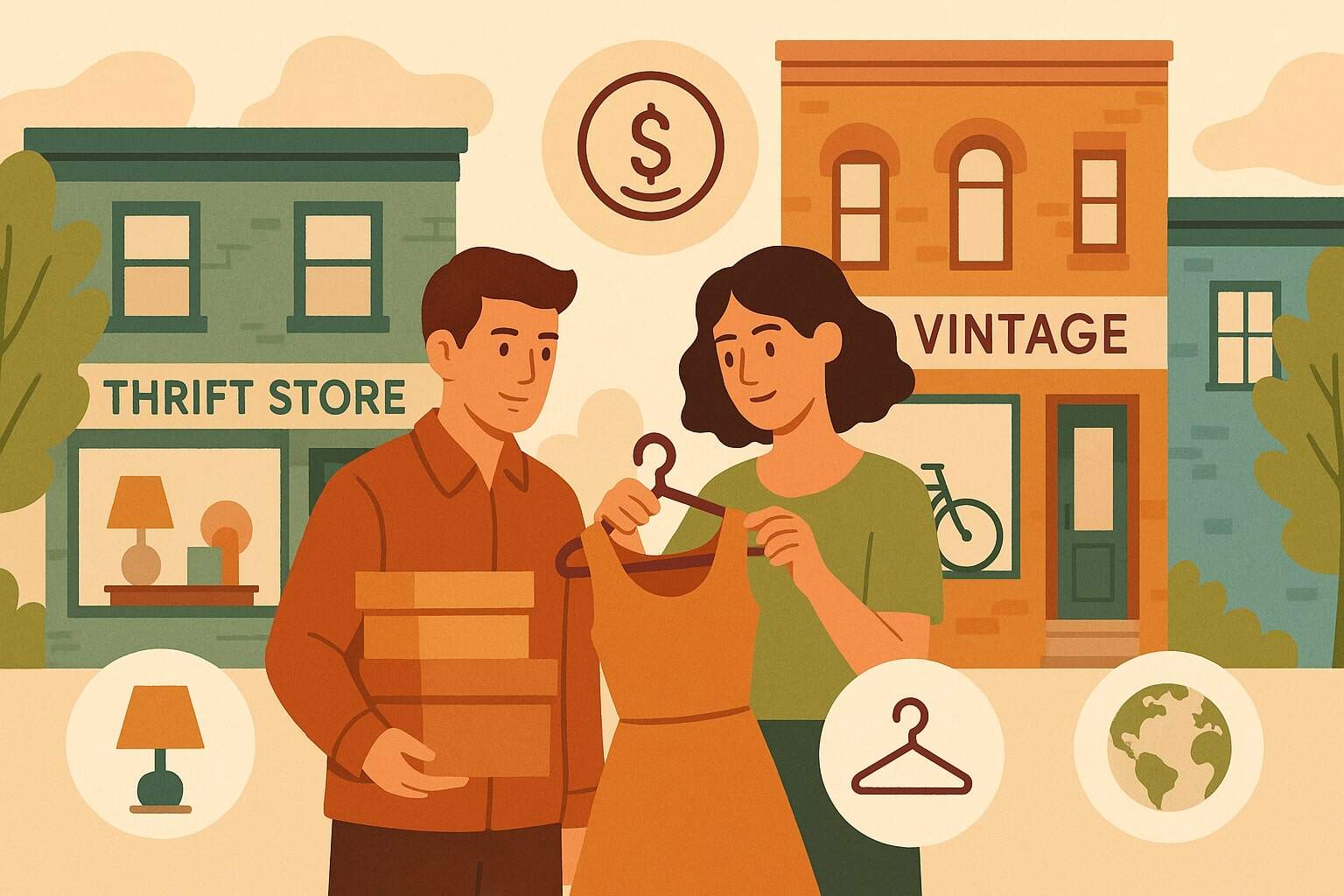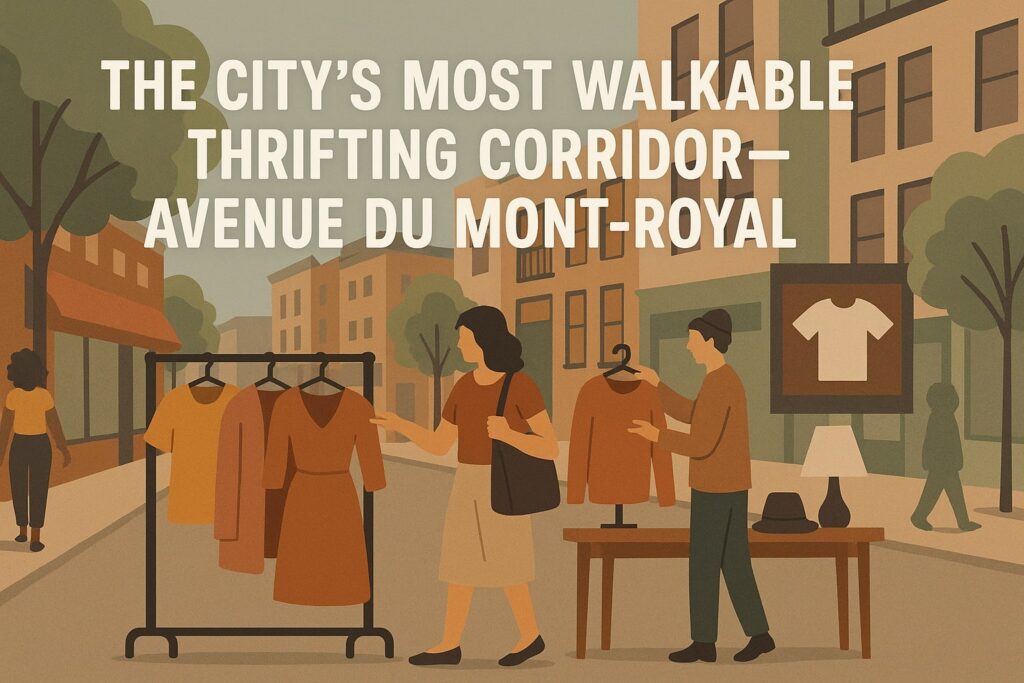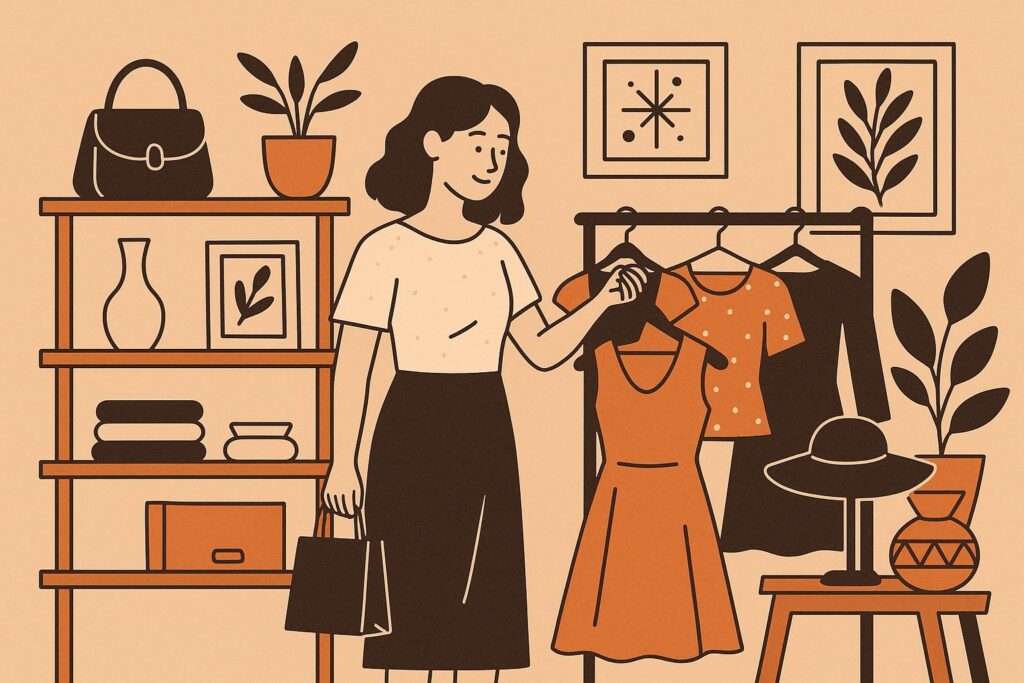
By bric-a-brac-montroyal November 5, 2025
Mont-Royal vintage and thrift shops are a rite of passage for style-hungry travelers and locals who want character over cookie-cutter. Set in the heart of Montréal’s Plateau-Mont-Royal, these stores live at the intersection of fashion, sustainability, and neighborhood culture.
In summer, the main drag—Avenue du Mont-Royal—often becomes pedestrian-only, turning the street into a lively open-air runway lined with secondhand gems, indie boutiques, murals, and café patios.
Dates vary by year, but 2025’s program closed large stretches from late May through early fall, with extended car-free zones between Saint-Laurent and Saint-Denis into October, making treasure-hunting easier and safer on foot.
Whether you want a curated designer piece, a $10 score, or a rockabilly dress with retro attitude, Mont-Royal’s best vintage and thrift shops deliver.
Flagship players like Renaissance (a Québec social-impact thrift network) and buy-sell-trade specialists like Empire Exchange sit alongside boutique curators such as Citizen Vintage, Annex Vintage, and the legendary Eva B. The result is a dense, walkable ecosystem where you can browse racks, sip espresso, and build a look that’s unmistakably Montréal.
Reason 1: The city’s most walkable thrifting corridor—Avenue du Mont-Royal

Mont-Royal vintage and thrift shops are clustered in one of Montréal’s most strollable high streets. Each summer, Avenue du Mont-Royal is transformed into a pedestrian promenade spanning about two kilometers, with pop-up plazas, installations, and free cultural programming that amplify the browsing vibe.
In 2025, closures stretched from Saint-Denis to de Lorimier from late May to early September, with an extra westward extension to Saint-Laurent through mid-October. That means more space to line up for fitting rooms, roll a suitcase for donations, or simply amble between stores without dodging traffic.
If you’re planning a “full-day thrift crawl,” time it with these dates to see why Mont-Royal vintage and thrift shops have become a seasonal urban ritual.
The city and local merchants also program art, terraces, and micro-events along the avenue—great for breaks between racks. Expect families, cyclists, and photo-snapping fashion fans; it’s the best backdrop for trying on a statement jacket and immediately seeing it “in the wild.”
If your trip isn’t in summer, don’t worry: the street is vibrant year-round and extremely metro-friendly via Mont-Royal station on the Orange Line, with frequent trains and level-up accessibility completed in recent years.
Reason 2: Curated boutiques where quality and creativity dominate

If your taste runs to hand-picked garments and reworked pieces, Mont-Royal vintage and thrift shops include boutiques that feel like mini style studios.
Citizen Vintage’s in-house Studio Citizen line is produced in small batches from dead-stock fabrics, with an upcycled collection that sits beside a rotating selection of vintage finds—ideal if you want the best of old and new in one stop.
Annex Vintage, in nearby Mile End, blends wearable vintage with local designers, printed books, and indie accessories, reflecting the neighborhood’s artsy DNA. These shops are perfect for shoppers who love edited racks, garment stories, and clear quality control.
For full-tilt sensory overload, Eva B is where Montréal’s maximalist heart beats loudest: a multi-level labyrinth mixing vintage, costumes, café sips, and surprise corners.
Its graffiti-splashed facade is famous, and reviews consistently describe it as a destination in itself. If your itinerary focuses on Mont-Royal vintage and thrift shops with character, Eva B is unmissable—great for statement coats, denim, and theatrical accessories.
Reason 3: Buy-Sell-Trade culture that keeps closets (and budgets) moving

One reason Mont-Royal vintage and thrift shops stand out is how easy it is to circulate your wardrobe. Empire Exchange popularized buy-sell-trade in Montréal, letting you book an appointment, get cash or store credit on the spot, and put your preloved pieces back into the local fashion loop.
The system rewards clean, on-trend, and seasonal items; and while buyers won’t accept everything, they’ll explain why—a gift for learning what sells. For thrifters traveling light, sell or trade early in the day to unlock same-day credit for your shopping circuit.
Buy-sell-trade is perfect for students and travelers stretching dollars while upgrading style. It’s also an eco-win: your garments bypass the landfill and get matched with new owners fast.
Pro tip: photograph your pieces under natural light, note measurements, and browse recent store posts to sense demand before you go. That way Mont-Royal vintage and thrift shops effectively become your revolving closet and your budget’s best friend.
Reason 4: Big-selection thrifts for everyday deals (Renaissance & Value Village)
If you love the thrill of the hunt, anchor your route with large-format thrifts. Renaissance (Fripe-Prix Renaissance Plateau) on Avenue du Mont-Royal E is a community-driven nonprofit where thousands of items hit the floor daily—clothing, shoes, homewares, books, toys, and electronics—priced without sales tax.
Their mission funds employment-insertion programs, so your cart helps people build work experience while diverting textile waste. Expect volume, quick turnover, and the joy of finding a perfect knit or jeans for a fraction of retail.
Beyond the Plateau, Village des Valeurs (Value Village) has several Montréal locations with aisles of apparel and housewares, well worth a detour if you’re assembling a capsule wardrobe on a budget.
Use their store locator to confirm the closest shop to your base; Jean-Talon Ouest is a common reference for visitors combining the thrift run with the nearby market scene.
Tip: go mid-week mornings for calmer racks, and scan endcaps for color-tag markdowns. Mont-Royal vintage and thrift shops become even more productive when you mix boutique precision with big-box volume.
Reason 5: Retro subculture, pin-up styling, and that rockabilly sweet spot
Mont-Royal vintage and thrift shops don’t stop at “vintage-ish.” They dive into specific eras and silhouettes. Kitsch’n Swell is a Plateau mainstay and widely described as Québec’s largest retro-and-pin-up boutique, specializing in 1920s–1950s-inspired clothing, plus sizes, men’s shirts, and accessories.
Think wiggle dresses, tiki prints, sunglasses, and the kind of styling advice that helps you own a look, not just wear it. If you’re chasing an authentic 50s vibe for a shoot, event, or just everyday joy, this is the target.
Even if your wardrobe leans modern, a single retro piece—cat-eye frames, a circle skirt, a bowling shirt—can transform a simple outfit. Try on with sneakers for a Montréal street mix, or go all-in with pumps, a scarf, and red lipstick.
The store’s curated racks and fitting-room energy are ideal for testing bold shapes. For a well-rounded day, pair Kitsch’n Swell with Citizen Vintage’s upcycled staples and Annex’s clean basics; the trio layers beautifully and keeps your Mont-Royal vintage and thrift shops versatile.
Reason 6: Real sustainability and local impact (not just buzzwords)
Thrifting here doesn’t merely “feel” sustainable—it is. Organizations like Renaissance operate a province-wide network that turns donations into funding for job-training and social inclusion, with stores and donation centers open seven days a week.
Buying a $7 paperback or a $15 sweater helps finance programs that change lives, while reducing textile waste. You can also donate your own items before shopping, boosting the circular economy that keeps Mont-Royal vintage and thrift shops vibrant.
Other players make sustainability tactile. Citizen Vintage produces small-batch garments from dead-stock fabrics and maintains an upcycled line, while Empire Exchange re-routes quality pieces back onto shelves via buy-sell-trade.
When your itinerary centers on Mont-Royal vintage and thrift shops, you’re supporting a fashion system that extends product lifecycles and funds community outcomes. That’s more powerful than a green label—it’s circularity you can see on the rack.
Reason 7: Café culture, side quests, and super-easy transit
Part of the magic of Mont-Royal vintage and thrift shops is everything wrapped around them: cafés for espresso breaks, indie bookstores for vinyl and zines, and public art that turns a shopping day into a neighborhood ramble.
In summer 2025 the pedestrianized avenue hosted installations and the RU festival, among other cultural moments—perfect for mixing style scouting with outdoor downtime. If you’re visiting in another season, many shops sit close to cozy cafés and bakeries on Saint-Denis and Saint-Laurent.
Getting there is simple. Mont-Royal is an Orange Line metro station with frequent service; STM notes 2–7 minute trains on weekdays and 6–10 minutes on weekends. If you’re in town longer, grab an OPUS card and consider a 24-hour or weekend pass; fare structures in 2025 reflect ARTM’s zone system, with Zone A covering Montréal proper.
Check STM’s official pages for current prices and occasional updates. Mont-Royal vintage and thrift shops plus reliable transit equals maximum ground covered with minimal effort.
Reason 8: Plan like a local—when to go, how to route, and where to pause
To get the most from Mont-Royal vintage and thrift shops, plan around timing and flow. Summer pedestrianization spreads out foot traffic, but weekends can still be brisk; go early for fresh restocks and quicker fitting rooms.
On non-pedestrian days, start near Mont-Royal metro, work east along the avenue for big thrifts like Renaissance, then swing west toward Saint-Laurent for retro and boutique hits. Slot in a mid-morning coffee on Saint-Denis, then lunch on a terrace during the car-free season.
If you want reliable “wins,” alternate curated and volume stops: boutique → big thrift → buy-sell-trade → boutique. This cadence lets you calibrate taste and budget on the fly, and it’s why Mont-Royal vintage and thrift shops are so addictive; you can compare quality, check comps, and circle back for the piece that got away.
A sample day itinerary (walkable, metro-friendly)
Start at Mont-Royal station and do a quick coffee-and-map check. Walk east to Renaissance (Fripe-Prix Renaissance Plateau) for a warm-up scan of jeans, knits, books, and housewares. Head back west into the denser boutique zone, popping into Citizen Vintage for upcycled staples and Annex Vintage for accessories and local-designer finds.
Take a lunch break; if the avenue is pedestrianized, grab a terrace seat and people-watch—this is where style ideas appear in the wild. After lunch, continue to Empire Exchange for buy-sell-trade browsing (and maybe cash in anything you brought), then finish at Kitsch’n Swell for retro joy.
If you still have energy, consider hopping on the Orange Line to check another Value Village elsewhere in the city. This loop keeps you on foot and within striking distance of the metro the whole time.
Pack and size smart for Mont-Royal vintage and thrift shops
A compact “thrift kit” pays off. Wear a base layer you’re comfortable trying under (or over) items, plus slip-on shoes for faster changes. Bring a soft tape measure and note your best-fit measurements (waist, chest, shoulder, inseam) in centimeters—many tags are vintage or international.
Photograph your closet’s gaps before you go so you shop with purpose: e.g., “dark straight-leg denim,” “neutral cardigan,” “event dress.” Set a budget envelope for alterations; a $20 hem can make a $12 skirt feel custom.
And travel with a lightweight tote that doubles as a donation bag—on Avenue du Mont-Royal, you can donate early at Renaissance or schedule pickup/drops with other organizations nearby before hitting boutiques.
Sell, donate, and declutter before (or during) your hunt
If you’re local—or staying long enough—clear space first. Empire Exchange takes appointments for buy-sell-trade; accepted items can earn cash or store credit the same day.
Le Magasin du Chaînon, the fundraising store for Montréal’s long-standing women’s shelter, operates a Plateau boutique and a Villeray donations hub; hours for shopping and donations differ, so check the current schedule.
Renaissance maintains a citywide network of donation centers and thrift stores, open seven days a week, with an interactive map to find the nearest drop-off.
Donating or trading early in your route lightens your backpack and funds your finds—one more way Mont-Royal vintage and thrift shops keep fashion circular.
Reason 9: Price-savvy strategies that stretch every dollar
Make dynamic pricing work for you. In big thrifts like Renaissance or Value Village, scan color-tag markdowns and endcaps first; these zones often hide the best cost-per-wear pieces. Use your phone’s notes to track fits and fabrics that love you—100% wool, heavy denim, flat-felled seams, cotton poplin—and aim your search there.
In curated boutiques, ask about upcoming drops or restock days; you’ll learn when your favorite categories (e.g., workwear, slip dresses, band tees) tend to hit the floor. For buy-sell-trade, stretch value by taking store credit if you plan to reinvest immediately—many thrifters treat credits as a “second wallet” reserved for gems.
When traveling in, consider transit passes. The ARTM’s 2025 fare reform still makes Zone A passes a smart play if you mix bus, métro, and REM within Montréal.
A 10-trip All Modes A can knock down the per-ride cost and keeps you flexible as you hop between Mont-Royal vintage and thrift shops and other neighborhoods like Mile End or Little Italy. Always confirm current fares before you load your OPUS.
FAQs
Q.1: What’s the best season (and day) to visit Mont-Royal vintage and thrift shops?
Answer: If your calendar’s flexible, aim for late spring to early fall when Avenue du Mont-Royal typically goes pedestrian-only. In 2025, large segments were car-free from late May, with an extension to mid-October west of Saint-Denis.
The car-free setup makes browsing calmer, gives more room for pop-ups and art, and shortens your walks between stores. That said, winter thrifting is underrated; inventory can be rich in wool, leather, and boots.
For any season, the best days are mid-week mornings when shop floors are freshly organized and fitting rooms are quieter. If crowds energize you, choose weekend afternoons during pedestrianization and treat the whole street like a festival runway.
Transit is straightforward all year thanks to Mont-Royal station on the Orange Line, with frequent service and step-free access.
Q.2: Which Mont-Royal shops are best for a first-timer?
Answer: Build a loop that blends curation and volume. Start with Renaissance (Fripe-Prix Renaissance Plateau) for inexpensive staples and books to warm up your “thrift eyes.” Jump to Citizen Vintage for small-batch upcycled basics and vintage highlights.
Pop into Annex Vintage for jewelry, local designers, and vintage-meets-modern pieces, then visit Empire Exchange to learn how buy-sell-trade works (and maybe offload an item or two). Cap the day at Kitsch’n Swell if you’re seeking pin-up silhouettes, retro menswear, or styling advice.
Sprinkle in a break on a Mont-Royal terrace during the car-free season. This mix shows you the full spectrum of Mont-Royal vintage and thrift shops—from $5 scores to studio-made slow fashion—with minimal transit hassle.
Q.3: How do I donate or sell items near Avenue du Mont-Royal?
Answer: You’ve got options. Renaissance runs donation centers and thrift stores across the island; the Plateaū location on Avenue du Mont-Royal E accepts donations and keeps seven-day hours (verify times on their live map).
Le Magasin du Chaînon operates a Plateau shop that funds the city’s longest-standing women’s shelter; note that donations are now routed through a dedicated Villeray center, and the Plateau location focuses on sales.
Empire Exchange handles buy-sell-trade by appointment; bring clean, in-season items to maximize acceptance and value (cash versus store credit). Doing your drop-offs first means you’ll shop lighter and with store credit ready to go—exactly how Mont-Royal vintage and thrift shops keep the circle turning.
Q.4: Is it easy to reach the area by public transit—and what fares make sense?
Answer: Yes. Mont-Royal station on the Orange Line sits steps from Avenue du Mont-Royal, and STM runs frequent trains (2–7 minutes on weekdays, 6–10 on weekends).
For fares, 2025’s ARTM updates kept Zone A relevant for most visitors staying within Montréal; consider a 24-hour or weekend pass if you’re thrifting hard or pairing your Mont-Royal vintage and thrift shops tour with Mile End, Little Italy, or the Village.
Regulars might prefer a 10-trip for a lower per-ride cost. Load fares onto an OPUS card and check STM pages for the latest prices or service notices.
Conclusion
Mont-Royal vintage and thrift shops are more than a shopping list; they’re a living, walkable culture. Between a car-free avenue in summer, a metro stop at the doorstep, and a lineup that spans nonprofit thrifts, buy-sell-trade hubs, and studio-made upcycling, this is the rare neighborhood where style, sustainability, and street life mesh perfectly.
You might arrive hunting for a specific denim fit or a statement dress, then leave with a bag of surprises, a coffee buzz, and a sense of having participated in Montréal’s circular fashion scene.
If you’re mapping an itinerary now, anchor it on Avenue du Mont-Royal, weave in Renaissance for volume, Empire Exchange for trade-ins, Citizen and Annex for edited racks, and Kitsch’n Swell for retro flair.
Time your visit with pedestrianization if you can, and ride the Orange Line to keep it effortless. That’s the recipe locals use—and why Mont-Royal vintage and thrift shops keep converting first-timers into thrifters.